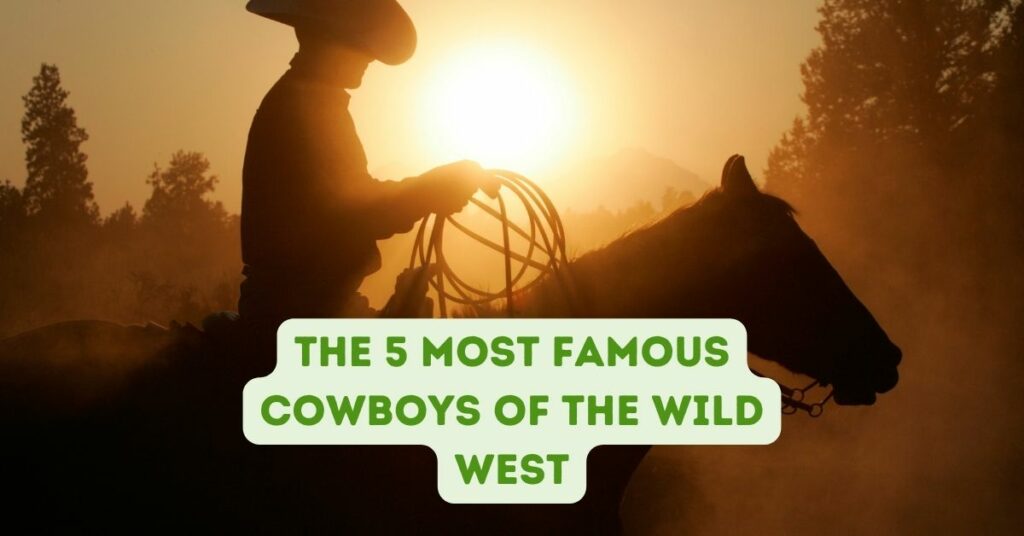As an Amazon Associate we earn from qualifying purchases.
The Wild West, a period of American history shrouded in myth and legend, gave rise to some of the most iconic and enduring figures of the American frontier. Among them were the famous cowboys, rugged individuals who became symbols of adventure, rebellion, and the untamed American spirit. These cowboys were not just herders of cattle or masters of the rodeo; they were lawmen, outlaws, gunfighters, and showmen whose exploits have been immortalized in books, films, and folk tales.
As we dust off the pages of history, we uncover the stories of the five most famous cowboys who left their indelible boot prints on the sands of time. From the notorious to the noble, their lives were as varied as the vast landscapes they traversed. Some wielded their revolvers with a deadly accuracy, while others used their charisma and sharp wits to become legends of the Old West.
Wild Bill Hickok: Daring Marksman of the Old West
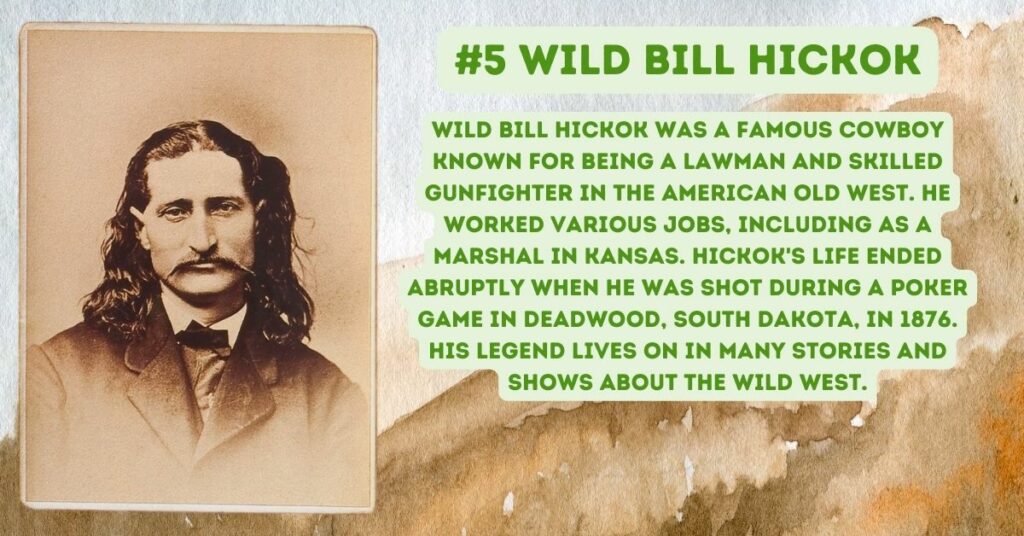
James Butler Hickok, better known as “Wild Bill” Hickok, was a figure who seemed to step right out of the pages of a dime novel, yet his life was as real and raw as the untamed West itself. Born in Illinois in 1837, Hickok would grow to become one of the most famous cowboys and gunfighters of his time, his reputation built on his uncanny marksmanship and a life that straddled the line between lawman and legend.
Wild Bill’s early years were marked by a restlessness that would define his entire life. He worked as a stagecoach driver and a lawman, but it was his skills with a pistol that etched his name into Wild West lore. Hickok’s fame as a sharpshooter began during the Civil War, where he served as a scout and spy for the Union Army, but it was after the war that his legend truly took shape.
In the post-war years, Hickok earned a reputation as a peace officer in the most lawless towns of Kansas, including Hays and Abilene, where his quick draw and calm demeanor in the face of danger helped to tame the tumultuous frontier. He was involved in several notable shootouts, which only served to bolster the tales of his exploits. Despite his role as a lawman, Hickok’s life was not without controversy or tragedy, and he was known to be involved in gambling and showmanship, touring with Buffalo Bill Cody’s Wild West Show for a time.
Perhaps the most famous story of Wild Bill Hickok is the manner of his death, which has become as legendary as his life. In 1876, while playing poker in a saloon in Deadwood, Dakota Territory, Hickok was shot from behind by Jack McCall, a man he’d reportedly beaten at cards the previous day. Hickok died holding a pair of aces and eights, a hand that would forever be known as the “Dead Man’s Hand” in his memory.
Wild Bill Hickok’s life was a tapestry of adventure, danger, and gunsmoke, making him the quintessential cowboy of the Wild West. His legacy endures not only in the stories passed down through history but also in the countless movies and television shows that continue to romanticize the life of one of the most famous cowboys of all time.
Jesse James: The Notorious Outlaw Hero
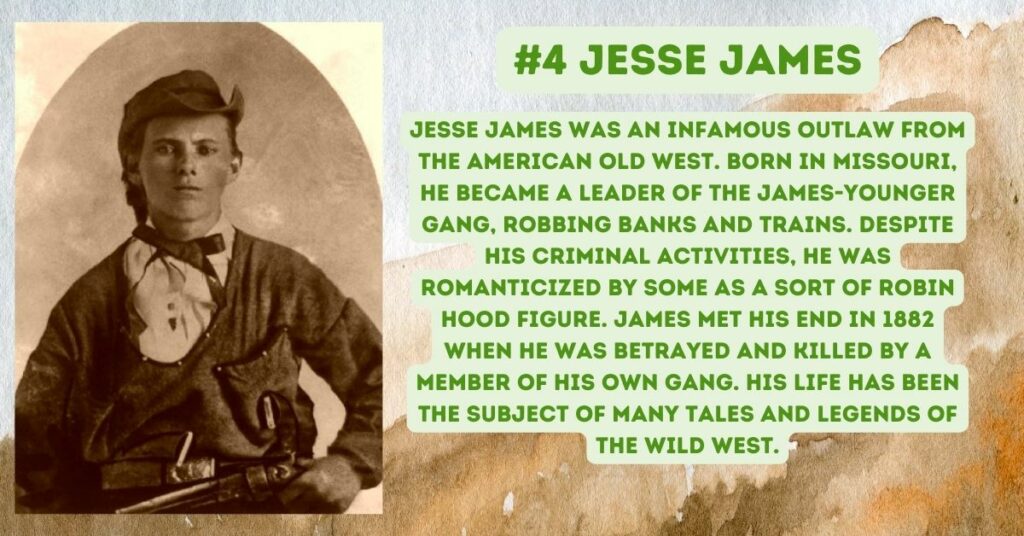
Jesse Woodson James is a name that conjures images of train robberies, daring heists, and the Robin Hood of the Wild West. Born in Missouri in 1847, Jesse James would rise to become one of the most legendary figures of his era, blurring the lines between villain and hero in the eyes of the public.
Jesse’s story is one of stark contrasts; a Confederate guerrilla during the Civil War, he later became the leader of the infamous James-Younger gang. With his brother Frank James and the Younger brothers, Jesse embarked on a notorious crime spree that included robbing banks, stagecoaches, and trains. The James-Younger gang’s exploits grabbed headlines, casting Jesse as a symbol of resistance against the perceived injustices of Reconstruction-era America.
Despite his criminal activities, Jesse James was romanticized by some as a modern-day Robin Hood, allegedly stealing from the rich and giving to the poor, although there is little evidence to support these claims. His ability to elude capture only added to his mystique, as did the sensationalist newspaper articles and dime novels that embellished his escapades.
The end of Jesse James came not in a blaze of glory but with a betrayal by one of his own. In 1882, Robert Ford, a member of his gang looking to collect a bounty, shot Jesse in the back of the head while he was straightening a picture on the wall in his own home.
Jesse James left behind a complex legacy, one of a cowboy who was as much a cold-blooded outlaw as he was a symbol of anti-establishment sentiment. To this day, he remains one of the most famous cowboys of the Wild West, an embodiment of the era’s lawlessness and the enduring American fascination with the rebel spirit.
Wyatt Earp: The Lawman of Tombstone
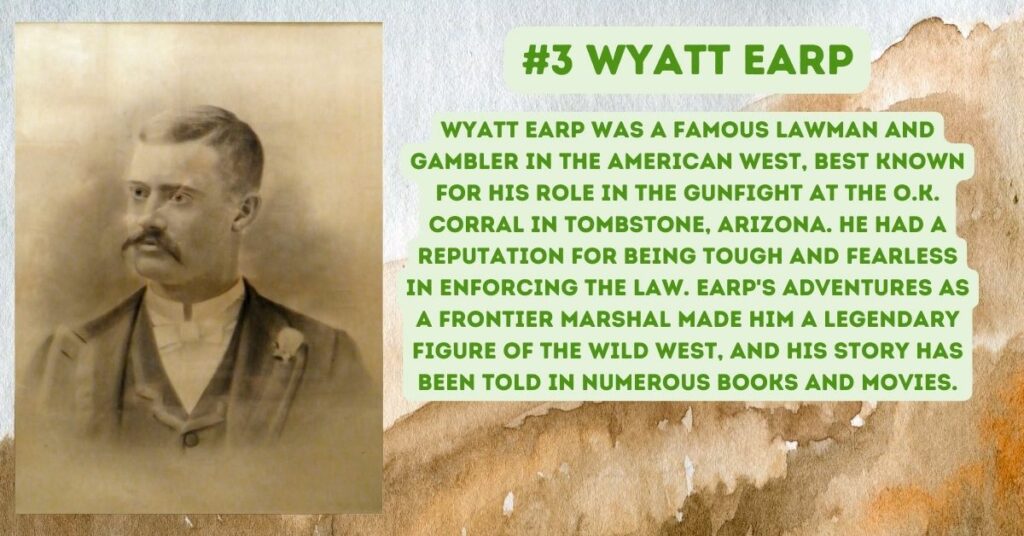
Wyatt Earp stands as a towering figure in the annals of the Wild West, a man whose name is synonymous with law and order on the American frontier. Born in 1848 in Monmouth, Illinois, Earp would become one of the most famous cowboys not for his skills with livestock, but for his role as a peace officer in some of the most lawless towns of the West, including Wichita, Dodge City, and, most famously, Tombstone, Arizona.
Earp’s life was the stuff of legend, marked by a series of gunfights that underscored the violent times in which he lived. However, it was the infamous Gunfight at the O.K. Corral where Wyatt Earp’s name was etched into immortality. On October 26, 1881, Wyatt, his brothers Virgil and Morgan, and his friend Doc Holliday, faced off against a group of outlaws known as the Cowboys in a 30-second shootout that left three men dead and several wounded. The event would become one of the most famous gunfights in the history of the American West, symbolizing the clash between lawlessness and the rule of law.
Earp’s life after Tombstone was no less eventful; he ventured into various businesses, including gambling, mining, and real estate. He wandered the West, from the boomtowns of California to the gold fields of Alaska, always searching for the next opportunity.
Despite his controversial life, which included accusations of being a vigilante and a gambler, Wyatt Earp’s legacy as a lawman has endured. He is often portrayed as the quintessential Western hero, a man who stood tall against the chaos of the frontier and became a symbol of American grit and determination.
The legend of Wyatt Earp, immortalized in countless books, movies, and television shows, continues to capture the imagination of those who are fascinated by the tales of the Wild West, making him one of the most famous cowboys in the lore of the American frontier.
Billy the Kid: The Infamous Young Gunfighter
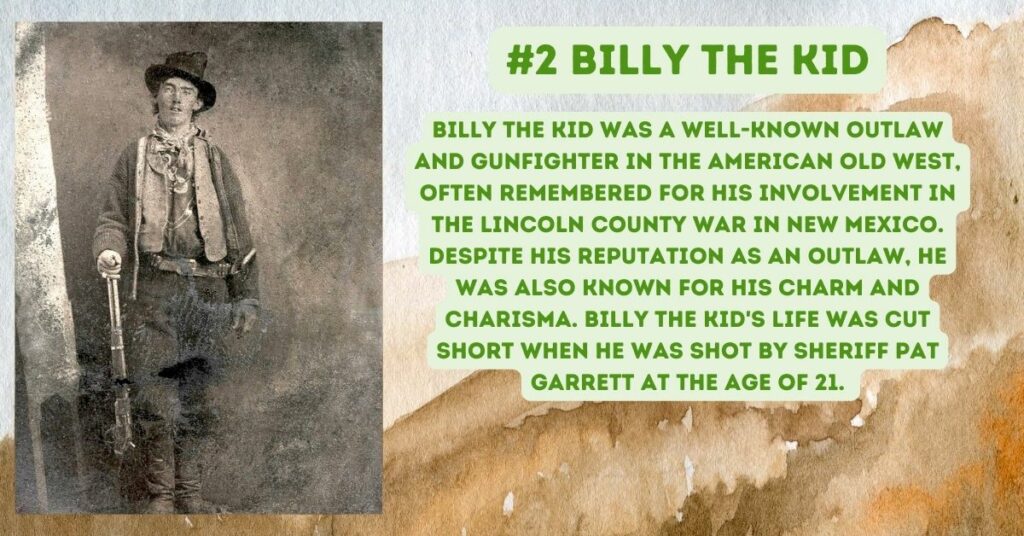
Henry McCarty, better known as Billy the Kid and also known as William H. Bonney, is one of the most iconic figures to emerge from the tapestry of the Wild West. His reputation as a fearless gunfighter and a notorious outlaw was cemented in American folklore before he even reached the age of 22. Born in New York City in 1859, Billy the Kid’s life would become a symbol of the untamed and rebellious nature that defined the era.
Billy’s notoriety began in the rugged territory of New Mexico, where he became embroiled in the Lincoln County War, a violent conflict between rival merchant factions. It was here that he earned his reputation as a skilled gunslinger and a charismatic outlaw, participating in bloody skirmishes and making daring escapes from the law.
Despite his criminal activities, which included cattle rustling, theft, and the alleged killing of 21 men—one for each year of his life, according to legend—Billy the Kid was described by those who knew him as affable and personable, with a magnetic charm that endeared him to friends and strangers alike. These qualities, along with his youth and the sensationalized accounts of his escapades, contributed to the romanticized image of the Kid as a tragic antihero caught in the cycle of violence of the times.
The legend of Billy the Kid was sealed on July 14, 1881, when Sheriff Pat Garrett, once his friend, tracked him down and shot him dead at Fort Sumner, New Mexico. The Kid’s life and death have been the subject of numerous books, movies, and songs, each adding to the mystique of the young outlaw who lived fast and died young.
Billy the Kid’s enduring fame rests on the mythical status he achieved in the years following his death, as tales of his exploits grew to epic proportions. Today, he remains one of the most famous cowboys and outlaws of the Wild West, a symbol of the era’s lawlessness and the enduring allure of the rebel figure in American culture.
Buffalo Bill Cody: The Showman of the Wild West
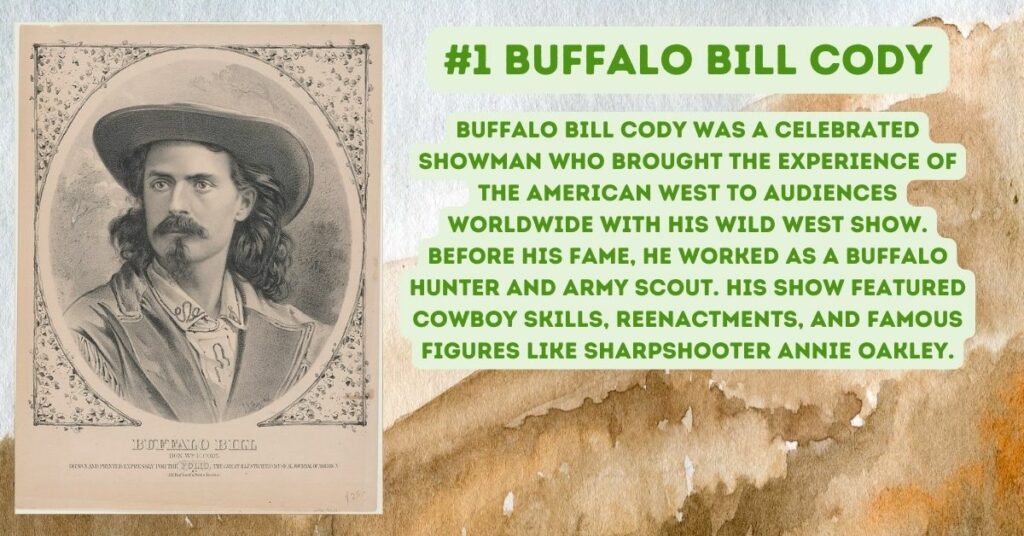
William Frederick Cody, known to the world as Buffalo Bill, holds the title of the most famous cowboy for his role in creating the mythos of the American West through his traveling frontier show. Born in 1846 in Iowa Territory, Cody’s life was a series of adventures that would make him the embodiment of the Wild West in the eyes of the world.
Buffalo Bill’s early experience as a Pony Express rider, Army scout, and buffalo hunter—where he purportedly earned his nickname by killing 4,282 American bison in eighteen months—laid the groundwork for his later fame. However, it was his Buffalo Bill’s Wild West show, which he started in 1883, that turned him into a living legend. The show featured reenactments of Indian battles, displays of marksmanship, and rodeo events, and it toured not just the United States but also Europe, bringing the myth of the American frontier to an international audience.
Cody was a master showman, and his Wild West show was a precursor to modern rodeos and circuses, celebrating the skills and drama of frontier life. He employed many notable Western figures, including sharpshooter Annie Oakley and Chief Sitting Bull, and his show left a lasting impression on how the West was perceived around the world.
Buffalo Bill’s impact on popular culture cannot be overstated; he helped shape the image of the cowboy and the West in the minds of millions, mixing fact and fiction in a spectacle that was part entertainment and part history lesson. His portrayal of the West was romantic and idealized, and it played a significant role in creating the enduring cowboy archetype that still captivates audiences today.
When William “Buffalo Bill” Cody died in 1917, he left behind a legacy that went beyond his showmanship. He was a symbol of the American frontier spirit, a man who celebrated and immortalized the cowboy way of life. His name remains at the forefront of the most famous cowboys in history, a testament to the power of his vision and the enduring fascination with the Wild West.
Amazon and the Amazon logo are trademarks of Amazon.com, Inc, or its affiliates.

Hey there, I’m Jasmine! I’m a total horse fanatic and have been working with these amazing animals for as long as I can remember. I’m passionate about sharing my love for horses with others and helping them learn more about these majestic creatures. As a professional horse trainer and riding instructor, I’ve developed a deep understanding of equine science and am committed to the welfare of horses. That’s why I founded OwnTheHorse.com, a blog where I share my knowledge and insights with fellow horse enthusiasts. I love connecting with my readers and building a friendly community of horse lovers. Whether you’re a seasoned equestrian or just starting out, I’m here to help and inspire you. Above all, I’m a friendly and compassionate person who truly cares about the well-being of horses and their human companions.

